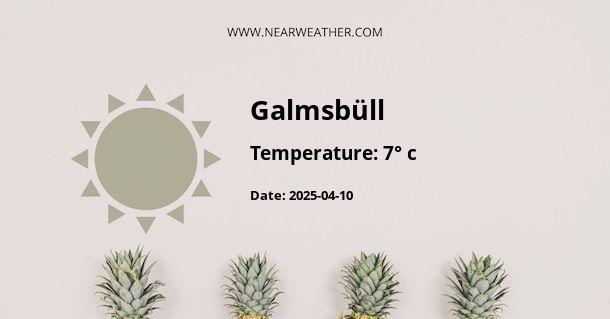Understanding the Climate and Weather Patterns of Galmsbüll, Germany
Galmsbüll, a serene municipality located in the district of Nordfriesland, in Schleswig-Holstein, Germany, possesses a climate moderated by its proximity to the North Sea. Like much of the region, it experiences a temperate oceanic climate with influences of maritime weather, leading to mild winters and moderate summers. To capture the essence of Galmsbüll's climate and weather, it's imperative to delve into seasonal variations, precipitation patterns, and prevailing wind conditions.
Seasonal Climate Overview
Understanding the seasonal nuances provides valuable insights for locals and visitors alike, helping in planning activities, agriculture, and understanding the potential impacts of climate change on the region.
Winter (December to February)
- Temperature: Average lows hover around 0°C (32°F), with occasional dips below freezing. Highs generally peak at around 5°C (41°F).
- Precipitation: Moderate, with snowfall less common due to proximity to the sea which brings milder temperatures.
- Wind: Can be particularly brisk, influenced by Atlantic depressions.
Spring (March to May)
- Temperature: A gradual increase, with averages ranging from 4°C (39°F) in early March to 15°C (59°F) by late May.
- Precipitation: Fairly evenly distributed, with slightly less rainfall compared to autumn months.
- Wind: Winds begin to ease but can still be gusty in March.
Summer (June to August)
- Temperature: Generally pleasant with an average high around 20°C (68°F), occasionally rising above 25°C (77°F).
- Precipitation: The area can experience occasional summer showers, but the total rainfall is generally lower during these months.
- Wind: Lighter winds in comparison to the rest of the year.
Autumn (September to November)
- Temperature: A gradual decline in temperature, starting with highs of 18°C (64°F) in September and lows around 2°C (36°F) in November.
- Precipitation: The season often sees the most precipitation, with frequent rainfall and stormy conditions driven by the Atlantic.
- Wind: Wind speeds increase as the season progresses, with several storms possible.
Year-Round Weather Averages and Extremes
The general climate statistics provide a frame of reference for the yearly weather patterns experienced in Galmsbüll. To represent these, we can refer to average temperature ranges and precipitation values recorded over the years.
| Month | Temperature (°C) | Precipitation (mm) |
|---|---|---|
| January | 0 - 4 | 60 |
| February | 0 - 5 | 40 |
| March | 1 - 8 | 50 |
| April | 4 - 12 | 40 |
| May | 7 - 16 | 50 |
| June | 10 - 19 | 70 |
| July | 13 - 21 | 80 |
| August | 13 - 21 | 80 |
| September | 10 - 18 | 90 |
| October | 7 - 13 | 100 |
| November | 3 - 8 | 80 |
| December | 1 - 5 | 70 |
Note that these are averages and actual conditions can vary significantly, sometimes exceeding these typical ranges.
Weather-Related Challenges and Considerations
Galmsbüll's location along the North Sea coast brings about specific challenges:
- Coastal flooding and erosion: Due to low-lying geography, particularly during storm surges.
- Agricultural impacts: The local farming practices must adapt to changing precipitation patterns and potential for late or early frosts.
- Energy production: The region's wind conditions are favorable for wind energy, which necessitates robust infrastructure to withstand harsh weather.
Influence of Climate Change
As observed worldwide, climate change poses a significant threat to the stability of regional weather patterns. In Galmsbüll and the wider Nordfriesland area, the shift could lead to:
- Sea-level rise affecting low-lying coastal areas.
- Increased intensity and frequency of storm events.
- Altered precipitation regimes potentially affecting the local ecosystems and agriculture.
Conclusion
In conclusion, weather and climate are crucial aspects of life in Galmsbüll, with implications for the regional economy, lifestyle, and ecology. Recognizing the various factors that influence the local climate, as well as the potential long-term changes brought about by global shifts in weather patterns, is vital for the sustainable development of the region.
For those who live in, visit, or study Galmsbüll, an appreciation of its seasonal weather patterns and the challenges posed by its coastal environment enhances the understanding of this unique area of Germany.
A - Galmsbüll's Latitude is 54.750000 & Longitude is 8.750000.
A - Weather in Galmsbüll is 7° today.
A - Climate Conditions in Galmsbüll shows overcast clouds today.
A - Humidity in Galmsbüll is 85% today.
A - Wind speed in Galmsbüll is 12.56 km/h, flowing at 316° wind direction. today.
